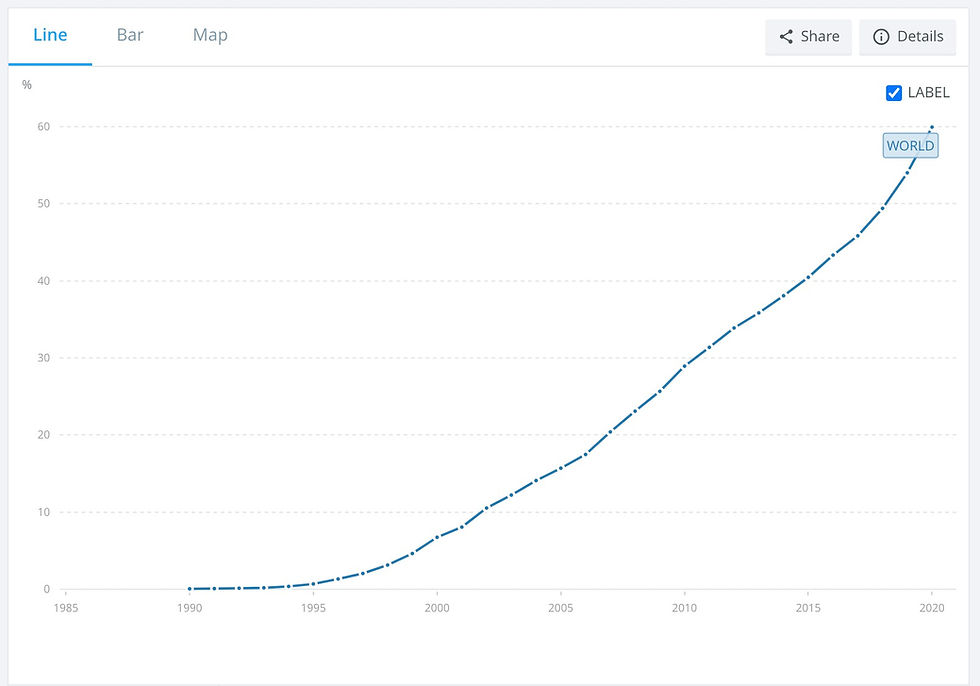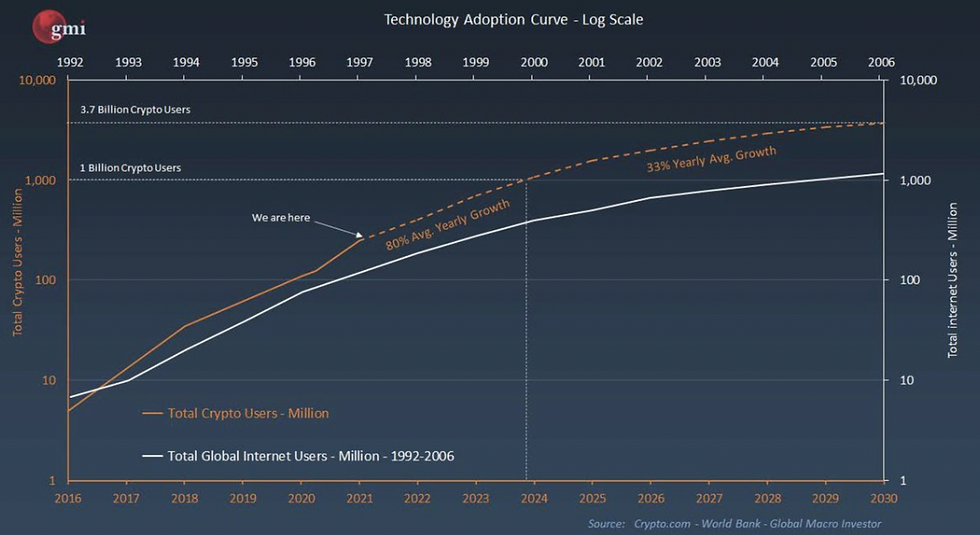We are in 1998
It took ±30 years for the internet to grow from technology innovation to what it is today.

source: World Bank
Bitcoin exists for 13.5 years and Ethereum was ICO'd since almost 8, but we are still at a very early stage when it comes to the big picture. End of last year Global Macro Investor (GMI) compared the adoption curves of the internet vs crypto. Following this chart, we are today with crypto where the internet was in 1998. Remember this is a log scale.

Crypto adoption today is where the internet was in 1998.
Crypto adoption speed, CBDCs, and price-innovation cycles
How likely is it that the adoption will grow as per the chart above? Below is a quote of GMI founder Raoul Pal's view on crypto as a new technology with massive network effects:
Already it is the fastest rate of adoption of any technology in human history (113% per annum vs 63% for the internet).
Further paraphrasing Raoul:
The chart above assumes a slowdown in adoption as more people come in. The question is: by how much will it slow down? Even if we slow to 63% per annum, we still get to a billion users by 2026. Then you need to add in the effect of CBDCs which create even larger networks that interoperate with the digital asset world.
Judging from the ECB's publications on the digital euro, it's clear several large economy CBDCs are coming our way soon.
Adding to that, the current ecosystem (funding dynamics, processing power, connectivity) has the foundations for shorter innovation cycles, supporting the narrative that crypto adoption will keep growing quicker than the internet did. For a better understanding of crypto's innovation cycle, Marc Andreessen’s view on the 'price-innovation' cycle as the first take away of a16z's 2022 State of Crypto report provides a good explanation. Andreessen Horowitz aka a16z is one of the few "traditional" VC firms that started investing in blockchain nearly 10 years ago.
Adding these two slides as a spoiler.


How about the current market crash?
Marc Andreessen summarized this well as follows:
"Markets are seasonal; crypto is no exception. Summers give way to the chill of winter, and winter thaws in the heat of summer. Advances made by builders during dark days eventually re-trigger optimism when the dust settles. .... As legendary investor Benjamin Graham (Warren Buffett was one of his most well-known disciples) once allegorized: It’s best to pay no mind to “Mr. Market”, who frequently boomerangs from exuberance and euphoria to despair and depression."
Consider that any prospective founders who swore off tech and the internet in the aftermath of the early-2000s dotcom crash missed the best opportunities of the decade: cloud computing, social networks, online video streaming, smartphones, etc.
To Graham’s wisdom a16z adds an addendum: Better to build and I fully agree. Building things is both the quickest and the most sustainable way towards learning and progress.
Where are the real world applications?
As with the internet, real world applications take time to build and adopt. Here are several cases that are making a difference:
Stellar's adoption in Nigeria
Minespider tracking minerals
Goldfinch expanding access to capital
Spruce on controlling your digital identity
Helium building low-cost telecom networks
Sound cutting out artists' middlemen
Flowcarbon for traceable carbon offsetting)
The issue is that these are more niche-focused. There are still not many cases that are part of our everyday private or professional life.
Harvard's view on the 'when'
For blockchain applications to be part of our everyday life, the transformative blockchain applications as described by Harvard Business Review in 2017 need to come into play (article: The Truth About Blockchain by Marco Iansiti and Karim R. Lakhani). That will take time. 10+ years, potentially more, according to HBR back in 2017. But the transformative applications are labeled as HBR's last adoption quadrant, meaning there are 3 other types of blockchain applications that will happen sooner (Single Use, Localization, and Substitution). And even on transformative applications, their opinion was clear - start small now and build blockchain capabilities:
Transformative applications are still far away. But it makes sense to evaluate their possibilities now and invest in developing technology that can enable them.
Executives need to ensure that their staffs learn about blockchain, to develop company-specific applications across the quadrants we’ve identified, and to invest in blockchain infrastructure.
In the next posts I will dive deeper into to HBR quadrants and see whether it's worth mapping blockchain in real estate use cases against them.
Conclusion
We're early. Markets are still volatile and full of speculation, and many people express a wide range of opinions. But that's explainable. Think about how it was back in 1998 and where we are now. Consider how the internet has made the real estate industry more efficient. Based on the above, when it comes to blockchain things may happen quicker this time.
We don't know anything for sure, but it’s good to be aware of the possibility that, due to blockchain alone, in the next 5-20 years doing business in our industry will get more efficient to different degrees depending on the area, impacting related jobs accordingly while adding a massive demand for new skills.



Comments